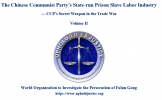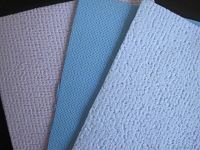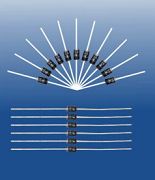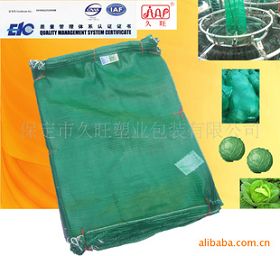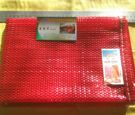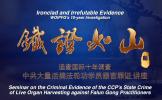WOIPFG’s Investigative Report on the Falun Dafa Practitioners’ Coerced Production of Forced Labor Products in the Chinese Communist Party’s Prisons and Labor Camps(part 2)
A4 format download 393_1523311690.pdf 1.8 MB
Letter format Download 393_1523311690_0.pdf 1.8 MB
Part 2 table of Contents
2. Slave Labor Products Made in Forced Labor Camps and the Companies that Commissioned them
2.1 Hebei Province Women’s Labor Camp and Related Companies
2.1.1 Hebei Yikang Cotton Textile Co. Ltd
2.1.2 Hebei Jinhuan Packaging Co. Ltd
2.1.3 Inner Mongolia Yili Industrial Group Co., Ltd. and Mengniu Dairy (Group) Company Limited
2.1.4 Hebei Electric Power Transmission and Tuoms Labor & Service Company in Shijiazhuang
2.2 Shanghai Qingsong Women’s Forced Labor Camp’s Third Brigade and Related Companies
2.3 Chongqing Women’s Forced Labor Camp, Chongqing Chang’an Automobile and Yaxuan Group Co., Ltd
2.4 Shaanxi Province Zaozihe Forced Labor Camp and Xifeng Brewery
2.5 Shanghai Forced Labor Camp and related companies
2.6 Xinkaipu Forced Labor Camp in Changsha City, Hunan Province and related companies
2.7 Shandong First Women’s Labor Camp and Beijing’s Shuanghe Medicine, Ltd
2.8 Masanjia Men’s Labor Camp and “Weshi (Wirge)” Down Jackets and “Bosideng” Down Coats
2.9 Masanjia Women’s Labor Camp
2.10 Former Hebei Women’s Forced Labor Camp Processed Arowana Brand Rice Packages
2.11 Baoding Balizhuang Labor Camp and Baoding Jiuwang Plastic Packing Co., Ltd
2.12 Xinjiang Wulabo Labor Camp, Xinjiang Women’s Labor Camp, Xinjiang Changji Labor Camp, Xinjiang No.3 Prison, Xinjiang No.5 Prison and Xinjiang Tianshan Wooltex Stock Co., Ltd
3. Forced Labor Products Made in Detention Centers and the Companies that Commissioned them
3.1 Shanghai Baoshan District Detention Center and Zhejiang Red Dragonfly Footwear Co. Ltd., Jiuguang Department Store
3.2 Qian’an Detention Center, Hebei Province and Changli County Hat Factory, Qinhuangdao City
4. Slavery products of unknown brands and for unknown companies
4.1 Sichuan Province Women’s Prison
4.2 Yunnan Province Second Women’s Prison
4.3 Kunming City Forced Labor Camp
4.4 Hewan Forced Labor Camp in Wuhan City
4.5 Heizuizi Women’s Forced Labor Camp in Changchun City, Jilin Province
4.6 Yunnan Province Women’s Labor Camp
Ⅱ. The Dangers and Risks of Slave Labor Products
(1) Slavery products directly damage the normal operations of the Chinese and international job markets and economies
(2) The temptation of enormous profits from slave labor products has made prison staff fiercer in persecuting the detainees, and some detainees have even been persecuted to death
(3) Products of slave labor pose serious threats to consumers’ physical health
1. Comparison of product safety between slavery products and regular products (source: Minghui.org)
2. The actual sanitary conditions in mainland Chinese prisons
3. Partial results from tests of detainees on contagious diseases
2. Slave Labor Products Made in Forced Labor Camps and the Companies that Commissioned them
Prior to the official abolishment of China’s forced labor camp system in December 2013, forced labor camps were illegal factories that had produced a massive quantity of slave labor products.
2.1 Hebei Province Women’s Labor Camp and Related Companies:
Hebei Yikang Cotton Textile Co. Ltd., Hebei Jinhuan Packaging Co., Ltd., Inner Mongolia Yili Industrial Group Co., Ltd., China Mengniu Dairy Company Limited and Hebei Electric Power Transmission and Tuoms Labor & Service Company in Shijiazhuang City.
2.1.1 Hebei Yikang Cotton Textile Co. Ltd.
The company has been exporting products for 30 years, and it is the parent company of L.B.E.P. Tech Corporation (formerly known as Hebei Yisheng Eco-technology Co. Ltd.) and Shijiazhuang Yifa Textile Co. Ltd. It owns a registered trademark “YK”. Its main products include grey fabrics, dyed fabrics, different series of diapers, beddings, bath products, children’s clothing, cleaning products, sanitation materials and green materials. These products are exported to several dozen countries, including Japan, Malaysia, Australia, the United States and Germany.[39]
Address: 177 Nanhuan East Road, Lingshou County, Hebei Province, China
Postal code: 050500
Client type: Agents and supermarkets
Board Chairman: Su Yiwei, male, 55, currently the general manager and party committee secretary of Hebei Yikang Cotton Textile Co. Ltd., 0311-82962619, 0311-82527107
Contact person: Ms. Xu Zhenzhen (deputy general manager)
Contact person: Zhao Yuan, Cell:15931090261, phone: 0311-66068260, fax: 0311-82511069
Contact person: Meng Jinpeng (salesperson), Phone: 0311-82516396, email: jaspercn@yahoo.cn
Contact person: Su Hui, phone: 0311-82527107, fax: 0311-82963968
The Hebei Province Women’s Labor Camp’s second and third brigades had been mostly working for Hebei Yikang Cotton Textile Co. Ltd. to produce microfiber cleaning cloths of 38-by-40 (centimeter) in size and pink, blue or yellow in color. Other products included diapers, eyeglass cleaning cloths, bamboo fiber kitchen cloths, french terry fabrics, car-cleaning cloths, glass-cleaning cloths, tea cloths, shower caps, polyurethane microfiber cloths and many others.[40]
Product photos:
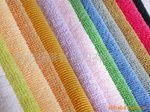
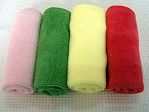
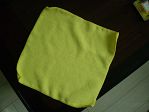
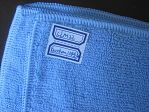
Microfiber cleaning cloths (the labor camp mainly produced cloths of pink, blue and yellow in color)
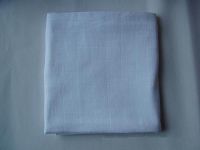
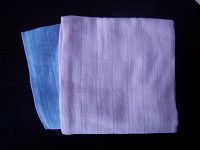
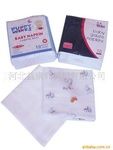
100% cotton diapers (the ones shown here don’t have any pattern on them; there are some ones with patterns – baby bears for boys and little princesses for girls)
|
|
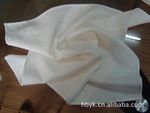 Microfiber tea towels (there are also blue and pink plaid ones besides the white ones illustrated here) |
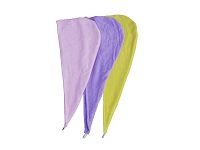 Shower caps |
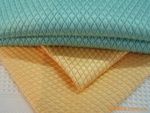 Microfiber french terry fabrics |
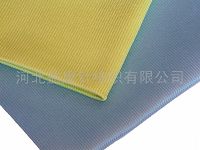
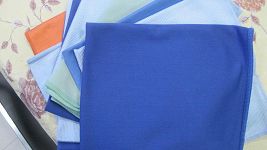
Glass-cleaning cloths (they mostly processed blue ones)
Production process:
Processing the three-color cleaning cloths involved the following steps: lock-stitching, burning and packaging. Lock-stitching was to lock stitch the hems of the pre-cut fabrics delivered from the factory with electric sewing machines. This step strictly required technical skills in sewing, spacing and positioning the trademarks. Burning was to burn out the extra thread ends. First, one would connect a bench-fixed iron wire with an electric transformer. After the wire became red hot, she would use it to burn out the extra thread ends after lock-stitching the fabrics. This step required the worker to avoid over-burning and loosening threads. Both the fabrics and threads used for lock-stitching were chemical fibers, which would emit irritating chemical gases upon burning. This would cause damage to people’s respiratory systems and eyes. Packaging was to package the cleaning cloths into boxes after burning. A great amount of chemical fibers from the cleaning cloths would hang in the air, causing harm to the respiratory system. Other products, such as diapers and glass-cleaning cloths, were delivered as finished products to the labor camp just for packaging. Each worker was assigned to finish lock-stitching 840 pieces of cloths per day; for beginners, it was 500 pieces per day. They were also assigned the quotas of burning 1,680 pieces of cloths and packaging 600 pieces of cloths.[41]
2.1.2 Hebei Jinhuan Packaging Co. Ltd.
Hebei Jinhuan Packaging Co., Ltd. was founded in 1992, with a total investment of 150 million yuan (approximately $23M). The company produces glass containers of various specifications for antibiotics, glass infusion bottle lids and oral solution bottle lids. Its products are widely used by Shanghai Roche, North China Pharmaceutical Co., Ltd., CSPC Pharmaceutical Group Limited (popularly known as Shijiazhuang Pharma Group), China Resources Sanjiu Medical & Pharmaceutical Co., Ltd., Harbin Pharmaceutical Group Corporation, Taiji Group Co., Ltd. and some other well-known pharmaceutical companies. Its products have also been exported in batches to Southeastern Asia, Northeastern Asia, the Middle East, Taiwan and other regions.[42] Contact person: Liu Baojun (sales manager)
Website: http://www.flipoffcap.com
Postal code: 050026
Address: Fangxing Road, Fangcun Development Zone, Yuhua District, Shijiazhuang, Hebei Province, China
Phone: 0311-85493431, 0311-85494902, 0311-85494847
Fax: 0311-85491174, 0311-85494907
Email: jinhuan@flipoffcap.com
The fourth brigade of Hebei Province Women’s Labor Camp was mainly processing aluminum-plastic composite bottle caps for oral solution bottles for Hebei Jinhuan Packaging Co., Ltd. There were different types of aluminum plastic bottle caps, which were golden, silver or blue in color (see the photo below).
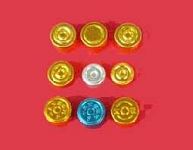
Bottle caps for Hebei Jinhuan Packaging Co., Ltd.
Production Process:
Processing oral solution bottle lids involved roughly three steps. First, the unqualified aluminum caps would be screened out, then rubber stoppers had to be inserted into the qualified aluminum bottle caps, and, finally, they would pass through the quality control, where defective products were picked out from the bottle caps stuffed with rubber stoppers on a large plastic disc. These steps were supposed to be done by specialized machinery in a strictly disinfected workshop. However, all of them were manually done by the fourth brigade of Hebei Province Women’s Labor Camp. Lid installation required clasping the rubber stoppers with a mold and then inserting them into the aluminum lids. The standard output required for each person in the fourth brigade was 10,000 gold aluminum caps per day. There were even patients of infectious diseases among the workers. The worktables were only wiped with wet rags before the work started. In order to speed things up, some people would use their fingers and nails to insert the rubber stoppers into qualified aluminum bottle caps instead of using their molds. Such packaging process was impossible to meet the sanitation requirements.[43]
2.1.3 Inner Mongolia Yili Industrial Group Co., Ltd. and Mengniu Dairy (Group) Company Limited
Between 2008 and 2009, Hebei Province Women’s Forced Labor Camp detainees undertook the work of putting handles on boxes for milk products for Yili (Inner Mongolia Yili Industrial Group Co., Ltd.) and Mengniu [Inner Mongolia Mengniu Dairy (Group) Company Limited]. They also made boxes for moon cakes, packaged toothpicks and chopsticks.[44]
2.1.4 Hebei Electric Power Transmission and Tuoms Labor & Service Company in Shijiazhuang
Hebei Province Women’s Forced Labor Camp’s second brigade folded shower curtains for the Foreign Trade Division of Hebei Electric Power Transmission and Tuoms Labor & Service Company. These shower curtains were said to be exported to many countries. The detainees also folded paper bags for cotton seeds. In 2012, the second brigade detainees were delegated to pick vegetables supplied by a vegetable company for a supermarket.
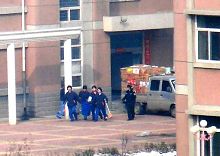
Inside Hebei Province Women’s Forced Labor Camp (partially enlarged picture), a loading truck was packed with boxes at the building entrance.
2.2 Shanghai Qingsong Women’s Forced Labor Camp’s Third Brigade and Related Companies
Shanghai Qingsong Women’s Forced Labor Camp’s third brigade worked with the Italian brand “My Doll”, Shanghai Three Gun (Group) Co., Ltd, women’s shoes retailer Daphne in Shanghai, Shanghai Haixin Group Co., Ltd. (and its three subsidiaries: Haiyan Toys Co., Ltd. of Shanghai, Haixing Toys Co., Ltd. and Haili Toys Co., Ltd.); Shanghai Global Toys Co. Ltd., Shanghai Yousheng Toys Co., Ltd., Shanghai Shenxin Toys Co., Ltd., Shanghai Changfu Toys Co., Ltd., Haojiang First Electronics Company, Qiaqia Food Co., Ltd. in Shanghai, and Red Triangle Stuffed Toy Factory in Xujing Town, Shanghai.
Falun Dafa practitioner Li Ying graduated from Shanghai Tongji University in 1992, with a major in business administration. She used to work for a consulting company in Shanghai. In October 2001, she was illegally sentenced to two years of forced labor and detained in Shanghai Qingsong Women’s Forced Labor Camp, due to her perseverance in practicing Falun Dafa.
Li Ying’s testimony:
“From June 2002 to April and May of 2003, the third brigade had been processing dolls. Some of the dolls were packaged and directly exported to Italy, and some were semi-finished products. The dolls were delivered directly to the labor camp in large sacks. They were in three sizes. The large dolls (Figure 1) came in 100-piece sacks, and the smallest dolls were 500 pieces in a sack. These dolls were stacked on the ground in the labor camp. Some grew moldy in the hot weather. However, since the dolls were put on clothes, no one could see how dirty their insides were. Those packaged and exported products all had production deadlines. The inmates and illegally detained Falun Gong practitioners had to start work every day before 7:00 a.m. Under regular circumstances, the detainees would finish working at 9:00 p.m., but most of them were usually made to work until 11 p.m. The labor camp’s quotas were calculated based on the workload of 10 hours, but most people wouldn’t be able to meet the quotas.”
 |
|
| Figure 1,In the picture, the dolls in both girls’ hands, their hats and pants are all slave labor products made in Shanghai Qingsong Women’s Forced Labor Camp. The doll in the hand of the girl on the right was packaged by the third brigade’s first squadron. In order to complete this product’s order by the deadline, the detained Falun Gong practitioners were forced to work until 2 a.m. in the morning. The flowers attached on the pants of the girl on the left were needle embroidered. The production requirements were that no stitch or burr could be seen, the flowers couldn’t be crooked at all, and the flowers couldn’t have edges or corners. The labor camp was only responsible for the flower embroidery to make semi-finished products. The hats of both girls, the flowers on the hats and the little houses with chimneys on the blanket were also made by the labor camp detainees. They were semi-finished products and composed of seven pieces of cloth. Each piece of cloth had to be embroidered in a certain order on the base cloth. The workload was 120 products per person per day.
|
Figure 2,The overalls worn by the doll on the left have some appliqués on them, and these are all hand-made. The collar of the overalls worn by the doll on the right was also embroidered with evenly distributed stitches. |
 Figure 3 |
 Figure 4,Both sides of the strawberry bag in front of the girl are embroidered to make the diamond-shaped blocks with a concave-convex feeling. This required evenly distributed stiches in straight lines. |
 Figure 5,The pants of the teddy bear sitting on the chair, the appliqués on the pants are semi-finished products embroidered by the labor camp. |
 Figure 6,The sun flower on the skirt worn by the first doll in the rear left was stitched onto the skirt. And the blue bib’s collar and hem were also embroidered with evenly distributed stiches, which were placed no more than 0.5 cm apart. No head ends or knots should be seen. The head flowers were also produced at the labor camp. |
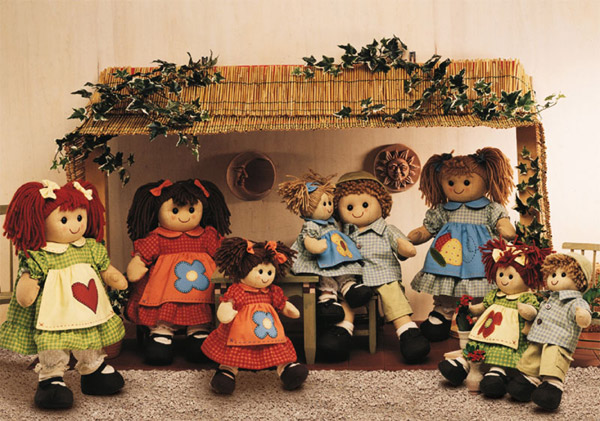 Figure 7 , The appliqués on all the dolls’ skirts were embroidered by the labor camp. The skirts’ collars and the bibs’ hems were also embroidered with evenly distributed stiches. |
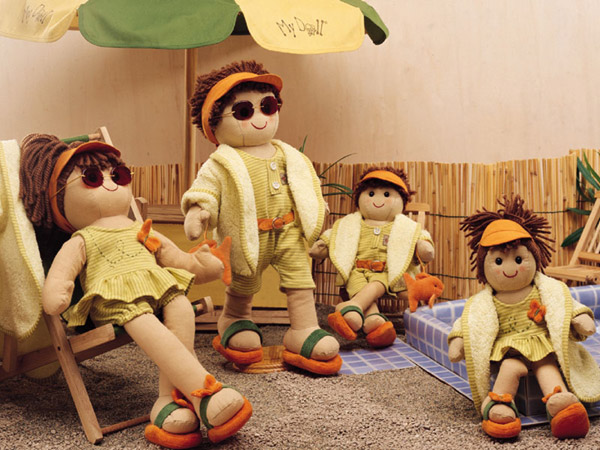 Figure 8,The butterflies and their flying paths on these dolls’ clothes were embroidered by the labor camp. |
The above pictures were downloaded from www.mydoll.it. The pictures on this website are just some of the products produced by Li Ying at the forced labor camp. Also, there are matching clothes and bags, which are individually packaged.[45] In addition, “each brigade of the Shanghai Women’s Forced Labor Camp has its own channels (to solicit orders). Therefore, there was a wide range of slave labor products, such as processed plush toys, processed shirts, processed shoes and electronics. Many companies near the Shanghai Women’s Forced Labor Camp have business ties with labor camps and prisons. However, there have also been many business groups and enterprises outsourcing their production and processing work to labor camps. These companies included Shanghai Three Gun (Group) Co., Ltd, women’s shoes retailer Daphne in Shanghai, Shanghai Haixin Group Co., Ltd. (and its three subsidiaries: Haiyan Toys Co., Ltd. of Shanghai, Haixing Toys Co., Ltd. and Haili Toys Co., Ltd.); Shanghai Global Toys Co. Ltd., Shanghai Yousheng Toys Co., Ltd., Shanghai Shenxin Toys Co., Ltd., Shanghai Changfu Toys Co., Ltd., Haojiang First Electronics Company, Qiaqia Food Co., Ltd. in Shanghai.”[46] The women’s labor camp’s second brigade was mainly processing plush toys (see the images below). Some of the detainees were “hired” by certain manufacturers. For example, Red Triangle Stuffed Toy Factory in Xujing Town, Shanghai, hired 50 detainees as its own company employees.”[47]
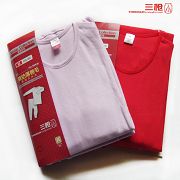 Three Gun brand cotton sweater & pants |
|
|
 |
 |
 |
Products manufactured by Shanghai Changfu Toys Co., Ltd.
Slave Labor Products Made in Shanghai Women’s Forced Labor Camp
2.3 Chongqing Women’s Forced Labor Camp, Chongqing Chang’an Automobile and Yaxuan Group Co., Ltd.
Chongqing Women’s Forced Labor Camp sent the younger practitioners detained there to a rubber shop to make fittings for the Chongqing Chang’an Automobile. After this workshop failed in December 2008, it was changed to making fittings for electrical wire installation.[48] The older practitioners were sent to a candy workshop to wrap candies. If one missed the quota by nine hours in one week, she would be forced to sit upright for two hours every night as punishment, if she was over 60 years old; or she would be forced to stand for two hours every night if she’s younger than 60 years old.[49]
The candy barrels and the boards used for the candy wrapping in the fourth brigade were filthy and covered with mildew. Mouse excrements were often seen mixed in with the candies. When the higher authorities came to inspect, the camp guards would order the detainees to hide all the candies. Any detainee, who mentioned ‘candy wrapping’ to outsiders, would get her term extended as punishment.[50]
The following are the product names and manufacturer of candies wrapped in the labor camp.[51]
Manufacturer: Yaxuan Group Co., Ltd.
Address: Industrial park, Yuzui Township, Jiangbei, Chongqing
Phone: 023-67580555
Fax: 023-67580788
Products of forced labor:
Rope candies - Happy family (see photo)
Boy & girl candies – Let’s get married
Fan candies - The predestined relationship of this life (see photo)
Long lollipops - Romantic journey
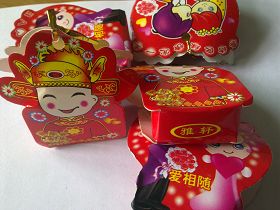 Rope candies |
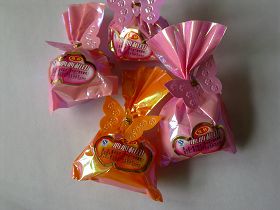 Fan candies |
2.4 Shaanxi Province Zaozihe Forced Labor Camp and Xifeng Brewery
Xifeng wine is the leading product of Shaanxi Province’s Xifeng Brewery. Located in Fengxiang County, Shaanxi Province, the Zaozihe Forced Labor Camp started manufacturing hand bags and packing bags for Xifeng Brewery in 2002.[52]
Shaanxi Xifeng Wine Marketing Co., Ltd
Address: Liulin Town, Fengxiang County, Shaanxi Province
Zip code: 721406
Tel: 0917-7421000; 0917-8612833 (sales phone)
Fax: 0917-8610999; 0917-7421100
E-mail: xfyx168@163.com
2.5 Shanghai Forced Labor Camp and related companies
Shanghai Forced Labor Camp cooperated and worked with Shanghai Haili Toys Co., Ltd., Red Triangle Stuffed Toy Factory in Xujing Town, Shanghai, Shanghai Haifa Toys Co., Ltd., Shanghai Changfu Toys Co., Ltd., Shanghai Toys No. 7 Factory, Shanghai Global Toys Co., Ltd. and Shanghai Haiyan Toys Co., Ltd.
Shanghai Haili Toys Co., Ltd. is one of the subsidiaries of Shanghai Haixin Group Co., Ltd. and specializing in the production and sales of various plush toys, some of which are exported to Europe and the United States. However, some of these products were produced in Shanghai’s forced labor camps.
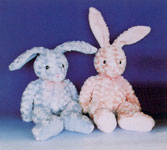
One type of the products of Haili Toys Co., Ltd.
Production process: The noses of the stuffed rabbits in the above photo were required to be embroidered with two threads at any given time. However, the “fast workers” would use four or six threads to sew the nose, in order to cut corners to complete their production quotas as soon as possible. They made several stitches and one nose was done. To sew the bows on the stuffed rabbits, it required sewing them back and forth several times. However, the “fast workers” made just one stitch to finish the job. For the rabbits’ eyes, it required sewing from the end of the neck up to one eye and then up to the head, then coming down to the other eye toward the end of the neck. Those “fast workers” just sewed from one eye directly to the other eye, without going through the proper steps.[53]

This is a building completed in 2004. The first floor is “Qingyuan Supermarket”, the second floor is the electronic products assembly line for the second brigade, the third floor is the electronic products assembly line for the fourth brigade and the fourth floor is a multi-purpose conference hall.
In addition to Shanghai Haili Toys Co., Ltd., the other companies in Shanghai, which have manufactured products in the labor camp include Red Triangle Stuffed Toy Factory in Xujing Town, Shanghai, Shanghai Haifa Toys Co., Ltd., Shanghai Changfu Toys Co., Ltd., Shanghai Toys No. 7 Factory, Shanghai Global Toys Co., Ltd. and Shanghai Haiyan Toys Co., Ltd.[54] In recent years, Shanghai has constantly seen many toy companies being established. A large number of toy manufacturers signed production contracts with labor camps to make profits.
2.6 Xinkaipu Forced Labor Camp in Changsha City, Hunan Province and related companies
Xinkaipu Forced Labor Camp in Changsha City, Hunan Province had used forced labor to produce wrappers for Tasty Duck Necks sold in Hunan, Chongqing and Zhengzhou; as well as inner wrappers for Hunan Special Crunchy Candies (sent to Loudi). It had also worked with the Southern Pearl International Hotel in Changsha, Changsha Weichu Great Kitchen, Kaiyan Foods, Daronghe, Jishou Xiangxi Ethnic Hotel, Jiuzhitang Co., Ltd. and many other companies.
Xinkaipu Labor Camp of Changsha, Hunan Province produced food wrappers and packages, including those used for ready-to-eat foods. The camp’s workplaces were full of dust and trash. The conditions were unsanitary and not suitable for any kind of production. Some criminal inmates (non-practitioners) even intentionally put sputum, snivel and feces on the products to vent their grievances.[55]
Products made here by forced labor: wrappers for Tasty Duck Necks sold in Hunan, Chongqing and Zhengzhou; inner wrappers for Hunan Special Crunchy Candies (sent to Loudi); chopsticks used at the Southern Pearl International Hotel in Changsha (sent to Changsha Weichu Great Kitchen, Kaiyan Foods, Daronghe and Jishou Xiangxi Ethnic Hotel); toothpicks for Pingxiang in Jiangxi Province; Hunan yogurt containers (the place of production is Anxiang County); chestnuts and packaged Yangtianxing Brand chestnuts; Pencheng Brand milk powder and Nanzai Brand milk powder; gift bags for Jiuzhitang Co., Ltd.’s Zhi Brand donkey hide gelatin blood-replenishing oral solution; Renbaoce Brand thermometers; Laiyang Brand throat tablets and other products.[56]
2.7 Shandong First Women’s Labor Camp and Beijing’s Shuanghe Medicine, Ltd.
Shandong Province First Women’s Labor Camp was also popularly known as Jinan City’s Jiangshuiquan Forced Labor Camp. From year 2002 to 2003, one of the tasks in the labor camp was to stick labels onto medicine packages. The labels were printed by Jinan City’s Tianyi Printing Company. (Formerly called the Donggang Company, it is known to the outside world as a company that produces high-quality carbonless copy paper.) These labels must be affixed on both inside and outside the packages. The contents are “Beijing’s Pressure Lowering No. 0” medicine produced by Beijing’s Shuanghe Medicine, Ltd.
Falun Gong practitioners, who were illegally detained in the first, second, and third brigades there, were forced to stick “Shuanghe” labels on the packages of “Beijing’s Pressure Lowering No. 0” products. The labels came in different shapes, such as rectangle, oval, etc. The medicine packages of “Beijing’s Pressure Lowering No. 0” were folded and packed tightly in cartons and delivered to the labor camp. The cartons came in two sizes. One large carton contained 2,000 medicine boxes, which were placed in two layers. The smaller carton could hold approximately 1,000 medicine boxes. Practitioners from the first, second and third brigades were each forced to put labels on at least 6,000-8,000 medicine boxes per day; some of them were even made to finish more than 20,000 boxes per person per day.[57]
2.8 Masanjia Men’s Labor Camp and “Weshi (Wirge)” Down Jackets and “Bosideng” Down Coats
In Masanjia Men’s Labor Camp, one of the forced labor jobs was sewing kids’ down coats and pants. They made down coats for many brands, including “Weishi (Wirge)” and “Bosideng”.[58]
2.9 Masanjia Women’s Labor Camp
Masanjia Women’s Labor Camp was part of Masanjia Re-education through Labor Institute. It was located in Masanjia Village, Masanjia Road of the Yuhong District of Shenyang City, Liaoning Province. It was a facility to “re-educate” women through labor. It not only detained and tortured Falun Gong practitioners there but also forced them to make slave labor products.
According to a report published on December 27, 2012 on the Daily Beast, an online magazine under Newsweek, Julie Keith of Portland, Oregon, USA found an SOS letter from a Chinese labor camp in the Halloween kit she purchased. The letter was folded eight times and tucked between two foam graves. The letter read, “Sir, if you occasionally buy this product, please kindly resend this letter to the World Human Right Organization. Thousands people here who are under the persecution of the Chinese Communist Party Government will thank and remember you forever.” “People who work here have to work 15 hours a day without Saturday, Sunday break and any holidays. Otherwise, they will suffer torture, beat and rude remark, nearly no payment (10 yuan/month).” “People who work here suffer punishment 1-3 years averagely, but without Court Sentence. Many of them are Falun Gong practitioners who are totally innocent people only because they have different believe to CCP. They often suffer more punishment than others.” In this unsigned letter, it was written that this grave package was produced by Unit 8, Department 2, Masanjia Labor Camp, Shenyang, Liaoning Province.[59]
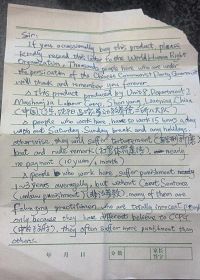
The above pictures are some products and children’s jewelry made by Falun Gong practitioners under duress in the Masanjia Forced Labor Camp in Shenyang City, Liaoning Province.
The pictures below are some exported products Falun Gong practitioners were forced to make at Forced Labor Camp in Liaoning Province.[60]
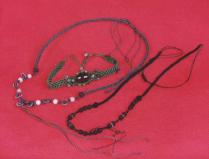 Necklaces and bracelets |
 Crafts |
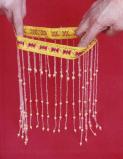 Children’s jewelry |
2.10 Former Hebei Women’s Forced Labor Camp Processed Arowana Brand Rice Packages
At the end of 2012, the former Hebei Women’s Forced Labor Camp made rice packages for the Arowana Brand. (The factory was located in the Luquan and Zhengding area.) Each detainee was assigned a certain output quota by the forced labor camp, and the output quota was incrementally increased. Those, who could not meet their quotas, were forced to work overtime. As a strictly supervised division, the fourth brigade produced most of the forced labor products here, including the Arowana Brand products.[61]
2.11 Baoding Balizhuang Labor Camp and Baoding Jiuwang Plastic Packing Co., Ltd
The detainees at Baoding Balizhuang Labor Camp were forced to assemble luggage combination locks (see picture below) and insert strings around the openings of the fruit and vegetable mesh bags for Jiuwang Plastic Packing Co., Ltd (see pictures below).
|
|
|
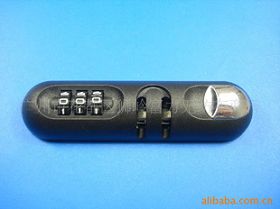 A luggage combination lock |
Baoding Jiuwang Plastic Packing Co., Ltd
Address: North of Zhuzhuang Village, Jiaozhuang Township, Nanshi, Baoding, Hebei, China[62]
Lian Yuncai: 13933250850
Lian Yunkai: 13930833433
Phone: 0312-2150388
Fax: 0312-2152883
Postal Code: 071000
2.12 Xinjiang Wulabo Labor Camp, Xinjiang Women’s Labor Camp, Xinjiang Changji Labor Camp, Xinjiang No.3 Prison, Xinjiang No.5 Prison and Xinjiang Tianshan Wooltex Stock Co., Ltd.
(1) Xinjiang Tianshan Wooltext Stock Co., Ltd. (hereinafter referred to as “Tianshan Wooltex”) was previously Xinjiang Tianshan Woolen Textile Co., Ltd., which was a joint venture with capital from Urumqi Tianshan Woolen Textile Co., Hong Kong Tianshan Woolen Textile Co., Ltd. (which consists of Hong Kong Peninsula Knitting Co., Ltd., Dongyang (Japan) Spinning Industry Co., Ltd.), Hong Kong International Cotton Industry Co., Ltd. and the Xinjiang Uygur Autonomous Region Supply and Market Cooperative.[63] After year 1990, in order to lower costs and compete in the international market, the company set up sweater workshops in Xinjiang Wulabo Labor Camp, Xinjiang Women’s Labor Camp, Xinjiang Changji Labor Camp, Xinjiang No. 3 Prison and Xinjiang No. 5 Prison.[64]
In August 2000, male Falun Gong practitioners being illegally held at different labor camps in Xinjiang were sent to the sixth brigade of the Changji Labor Camp. This division became the designated place for the persecution of Falun Gong practitioners. It was also the main location, where products for Tianshan Wooltex were made and processed. From 2000 to 2002, more than 50 Falun Gong practitioners were forced to work for Tianshan Wooltex in labor camp workshops.[65]
When Tianshan Wooltex received an order, it would send it over to the labor camps and prisons, at the same time providing them with raw materials. It would also give a deadline, by which time Tianshan Wooltex would buy back the finished products at an extremely low price. In order to meet the deadline and earn an exorbitant profit, prison guards often coerced the detainees to work overtime without sleep for several days straight. Many detainees at Xinjiang Changji Labor Camp’s first brigade were routinely deprived of sleep for 10 to 15 days. They would work an average of more than 20 hours a day. They could only take a short nap after dawn on the platforms, where they made the sweaters. When operating the machines, they had to stand for an entire day and night, often making their legs swollen. The workshop was located only 200 meters from the canteen, but the detainees often did not have time to dine there. They often took a bucket of porridge back to the workshop and continued working after a quick meal.[66]
When seeing workers fall asleep, the guards would shock them with electric batons and order the head of the workshop (who was also an inmate) to beat them hard with bricks and sticks. If one detainee failed to complete his assigned work, the guard would cuff him to a heating pipe, strip him naked and shock his neck, armpits, lower abdomen, private areas, mouth and ears violently with electric batons, in addition to extending his detention term. They were especially malicious in torturing Falun Gong practitioners. The prison guards (i.e. policemen) from the sixth brigade forced Falun Gong practitioners, who were determined to keep their faith, to do heavy manual labor, to dig vegetable cellars during the day and knit sweaters all night long. Exhausted Falun Gong practitioners often fell asleep at night while knitting the sweaters, and the guards would then poke them with long needles and scissors. The left hand of Falun Gong practitioner Wang Jianping from Karamay was handicapped, and he was slow in knitting the sweaters, so the guards often threw bricks onto his chest and back. Sometimes when the practitioners made a mistake, the inspector would take the opportunity to beat them, verbally abuse them and extort money from them. Tianshan Wooltex often forced detainees with no source of income to pay for damaged sweaters, and the result was that the detainees, who couldn’t pay, received an extension to their terms.[67]
Since the detainees were not allowed to take a shower for very long periods of time, lice from their bodies, along with pus and blood from scabies patients were often rubbed off on the sweaters. And since the inmates loathed being treated as slaves, they intentionally wiped the filthiest things on the sweaters as a form of revenge. However, as the sweaters would be ironed and reshaped before they were sold or exported, the dirty things and blood usually became invisible after the final step.[68]
However, the “Tianshan” trademark was identified as a “famous Chinese brand” by the State Administration for Industry and Commerce, certified by the Xinjiang Uygur Autonomous Region Administration for Industry and Commerce as a local famous brand, and awarded by mainland China’s General Bureau of Commodity Quality Supervision, Inspection and Quarantine as one of “China’s brand-name products in 2003” and a “quality inspection-waived enterprise in 2002-2005”. They even obtained the IQNet international certification. Moreover, Tianshan Wooltex has produced a large number of sweaters and cashmere sweaters for over a dozen well-known international brands, such as (except for TSE of Tianshan’s Hong Kong Subsidiary) Banana Republic, Neiman Marcus, Holt Renfrew, Ports, Minimum, Bon Genie, Tutti Colori, Espina, Cream, Anivee F, Son Jung Wan, French Connection and others. Orders from Banana Republic would number between 200,000 and 280,000 per year.[69]
XINJIANG TIANSHAN WOOLTEX STOCK CO, LTD.
ADDRESS: NO.1 YINCHUAN ROAD, URUMQI, XINJIANG, CHINA
POST CODE: 830054
TEL: 0086-0991-4311866-6834
FAX: 0086-0991-4310472
E-MAIL: business@chinatianshan.com
Website: http: //www.chinatianshan.com
E-mail: tsjszx@chinatianshan.com
Company legal representative: Zhang Ziqiang
XINJIANG TIANSHAN WOOLTEX HONGKONG OFFICE LTD。
ADDRESS: BLOCK B&C,9/F,702 CASTLE PEAK ROAD,HOP HINGIND.BLDG,KOWLOON,HONGKONG
TEL:852-27418591
FAX:852-27860197
(2) In Xinjiang Changji Labor Camp, the policemen and prisoners often forced Falun Gong practitioners to be brainwashed. Those who refused were dragged out and subject to beatings and electric baton shocks. Then they had to continue working the next day. They were tortured again if they couldn’t complete the work. Every day they worked over 16 hours. Other than Falun Gong practitioners, criminal offenders were also forced to do slave labor work. Due to prolonged overwork, sleep deprivation, malnutrition, stress and no medical care, many detainees contracted tuberculosis, hepatitis, scabies, asthma and other infectious diseases, but they were still forced to work.
3. Forced Labor Products Made in Detention Centers and the Companies that Commissioned them
3.1 Shanghai Baoshan District Detention Center and Zhejiang Red Dragonfly Footwear Co. Ltd., Jiuguang Department Store
The Baoshan Detention Center in Shanghai, known as the “No. 1 detention center in the Far-east,” is an institution where heavy daily forced labor is imposed. Its products include boxes for contact lenses, packages for brand-name mooncakes, manuals used in some Japanese theme parks, shoe boxes for Zhejiang Red Dragonfly Footwear Co. Ltd. (see the picture below) and holiday shopping bags for the Jiuguang Department Store. All of these products have been made by detainees in cramped, locked cells.[70]
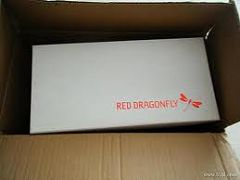
a Red Dragonfly shoe box
3.2 Qian’an Detention Center, Hebei Province and Changli County Hat Factory, Qinhuangdao City
The Changli County Hat Factory of Qinhuangdao City processes 6 or 7 different kinds of products in Qian’an Detention Center, Hebei Province. The hat factory sends semi-finished product materials to the detention center. The detainees there have to sit on their beds or on the ground in their cells to make the hats.[71]
Production Process: Using big needles made from discarded ball pen refills, the detainees would weave zigzag patterns on the outer rings of the hats with plastic flat threads. Certain patterns are also required to be made on the inner rings of the hats. Then they would stitch the outer ring, the inner ring and the cap top together and insert the strings.[72]
Product photos:
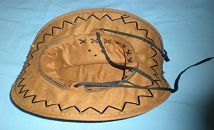
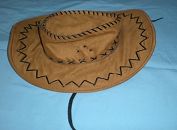
Production process: Using a stainless-steel tube, the detainees drill into the hawthorn’s head with its thick end, then aim at the hawthorn’s tail with its thin end to poke the pit out. Everyone has to extract pits from 20 to 25 kilograms of hawthorn fruits every day. Since the stainless-steel tube is very sharp and the hawthorn pit is very hard, it’s very easy to injure their hands, but the detainees have to keep working with their injuries.[73]
4. Slavery products of unknown brands and for unknown companies
4.1 Sichuan Province Women’s Prison
A Falun Gong practitioner, who had been illegally incarcerated in Sichuan Province Women’s Prison provided the following drawings, which are the patterns of the products she made in prison. She had performed many different tasks in the prison, including making wigs and braids (for mannequins), shoe uppers, mooncake boxes and envelopes. The prison would take any jobs that are profitable. The elderly and weak would knit sweaters, make embroidery on insoles and make fire crackers.[74] Other products of slavery include beaded purses for young girls, beaded handbags and cross-shoulder bags for ladies, beaded patterns such as butterflies, beetles, puppies, apples, bananas and cartoon figures. According to production instructors and quality control inspectors from the company that assigned the work to the prison, all these products are for export.[75]
These are the patterns of the slavery products:
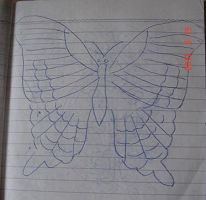 |
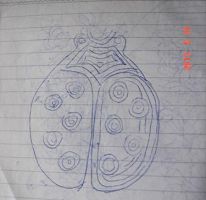 |
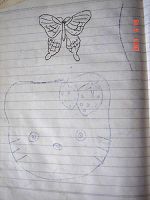 |
 |
This female practitioner said, “Sichuan Embroidery can be classified into single-sided and double-sided embroidery. Usually, one string is divided into several threads when sewing. These patterns are the embroideries on handkerchiefs that would be sold at the tourist site called “Sanxingdui”. There are many patterns that are similar to these. There are also large pieces of embroidery. When I was enduring persecution in the prison, I had made embroidery on Korean style women’s ceremonial dresses that would be exported to South Korea. On these dresses, we applied Manchurian style embroidery on the collars and sleeve cuffs.”[76]
Sichuan Embroidery patterns on the handkerchiefs sold at Sanxingdui tourist site:
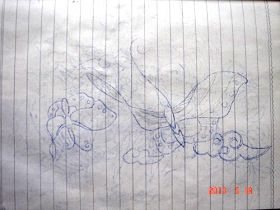 |
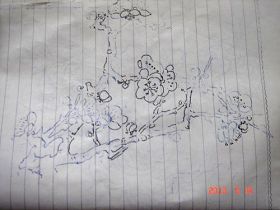 |
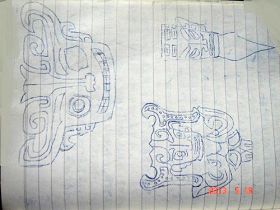 |
The following are Cantonese-style embroidery patterns sewn on quilt covers.[77]
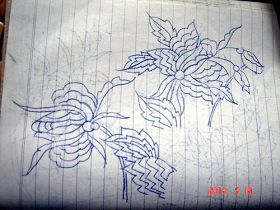 |
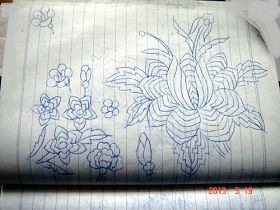 |
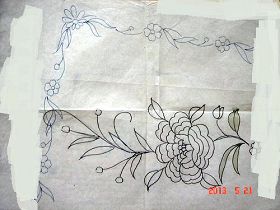 |
For more embroidery patterns, please download them from the link below (3.7MB)
http://pkg2.minghui.org/mh/2013/8/26/yue-xiu.zip
4.2 Yunnan Province Second Women’s Prison
There are many prison sections in the Yunnan Province Second Women’s Prison, and inmates in all these sections engage in slave labor production except the ninth section. Even the people in the eighth section, where elderly and handicapped detainees are held, have to perform forced labor. Among them, the first, second, third, fifth, sixth and seventh sections engage in making adult apparels, which are mostly uniforms, as well as some fashionable clothes. The fourth and eighth sections engage in the production of handicrafts, such as purses, crafts, embroideries, beadings and bracelets. These are mostly Yunnan ethnic style fashion accessories and purses. The patterns look like the pictures below:[78]
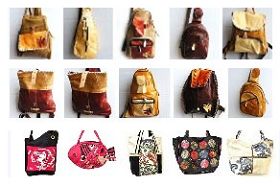 Leather Purses and Fabric Purses |
 Purses and Bracelets |
4.3 Kunming City Forced Labor Camp
Formerly known as Kunming City Drug Rehabilitation and Reeducation through Labor Institute and located at Wangdaqiao area of Kunming, the Center was renamed Kunming City Reeducation through Labor Institute in March 2009. At that time, its gate was flanked by two signs: that of the Labor Camp and Kunming City Drug Rehabilitation Center. The forced labor camp was transferred to the new center at Chenggong at the end of year 2009.
The labor camp had several business partners, all of which were local private enterprises and sole proprietorships. The products of slavery from this labor camp were sold at local tourist sites, and some were sold in other provinces and even exported to foreign countries.[79]
Categories of slavery products:[80]
(1) Chinese handicrafts, such as dolls of different ethnic groups in China, which were sold in all major tourist sites in China

(2)Decorative buttons and fabric arts on bags
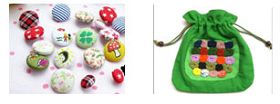
(3)Various kinds of purses, fabric bags and handbags (exported to Japan)
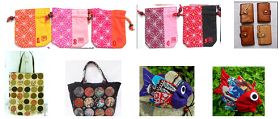
(4) Embroidery

(5)Wigs

4.4 Hewan Forced Labor Camp in Wuhan City
On the gate of the sixth brigade of Hewan Forced Labor Camp, there was a large sign with the name of an apparel factory on it. In addition, this brigade had several licenses for other types of business.[81]
 |
 |
The sweater on this toy dog is a product from the eighth brigade of Hewan Forced Labor Camp. Some detainees were required to knit 8 to 10 sweaters every day. The fabric flowers on the right are also made by this labor camp’s eighth brigade. Everyone was required to make several dozen pieces every day, earning a few cents (RMB) for each piece. The detainees also processed some small flowers on wedding gowns. They had to produce a lot of such flowers every day, and this would damage their eyes in the long-term. They had also done yarn unraveling, product packaging and book binding. Whatever could make profit, the labor camp would try to get the business from one of its business partners.[82]
4.5 Heizuizi Women’s Forced Labor Camp in Changchun City, Jilin Province
Butterflies made by Falun Gong practitioners detained in Heizuizi Women’s Forced Labor Camp in Changchun City, Jilin Province[83]
 |
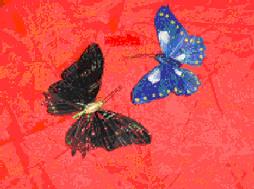 |
4.6 Yunnan Province Women’s Labor Camp
Yunnan Province Women’s Labor Camp was known as “Yinsheng School” to outsiders.
Major products of slavery labor from this labor camp were:[84]
(1) Polishing and washing gems and gluing gems together. Limewater was used to polish gems. There were no protective measures used at all. The detainees’ hands would quickly get swollen and have broken skin and fester. They had to work under intense fluorescent lighting. Many detainees got dizzy, and their visual acuity would quickly decrease. Gradually, their vision would become blurry, and their eyes would become very sensitive to light. And they often suffered from itchy, watery eyes.
(2) Picking mushrooms. The wild mushrooms from the pine forests in Yunnan Province could be preserved for a long period of time in concentrated brine solution. The detainees had to pick the mushrooms with their hands directly from the brine solution.
(3) Transferring feces from one place to another and working in the farm field – digging, planting vegetables, digging pools, picking garbage, etc.
(4) Cutting and aligning zippers. If one had not completed her quota, or the quality was not up to par, she could not take a break.
(5) Embroidery and sewing. If one had not completed her quota, or the quality was not up to par, she could not take a break.
(6) Making toys. Workers had to have contact with toxic substances, which emitted strong smelly odors.
(7) Making bracelets. If one had not completed her quota, or the quality was not up to par, she could not take a break.
(8) Sorting soybeans (removing bad soybeans from big piles of soybeans): Each detainee was assigned to sort through several hundred pounds of soybeans. If the result was not up to par, she had to do it all over again.
(9) Carrying big carton boards.
(10) Some detainees were taken out of the labor camp to perform slavery labor elsewhere, so that the guards in the camp could make some extra money from their work.
(11) Imitating brand-name products. Any brand-name products on the market could be imitated. The detainees were also forced to produce low-quality products, including joss paper money.
These labor camps knew how to get away from food safety inspections. Cookies, foods, disposable chopsticks and many other products were produced in very unhygienic environments. Many detainees, who made these products, were drug addicts. And many of them were carriers of liver disease viruses and HIV viruses.
Ⅱ. The Dangers and Risks of Slave Labor Products
According to the “Investigative Report on Slave Labor in Prisons in Communist China” published on Minghui.org, more than 100 types of slave labor products have been revealed in the recent several years. They are from a wide variety of categories – food, clothing, housing, travel, recreation, skin care and cosmetics, wedding and banquet-related products, funeral-related products and products for festival celebrations. At the same time, since many companies in China, especially exporters, have worked with the “enterprises” registered by labor camps, prisons and detention centers, large quantities of slavery products have been exported, through these companies, to over 30 countries and regions, including the U.S., Australia, India, the U.K., Japan, South Korea, Russia, Germany, Africa, Turkey, Italy, some Arab countries, Malaysia, Canada, Hong Kong, Macao and Taiwan.[85] These slavery products’ circulation on the market not only hurts the slave workers, but it also causes tremendous harm to and negative impacts on the society.
(1) Slavery products directly damage the normal operations of the Chinese and international job markets and economies
According to data released by the United Nations’ International Labour Organization (ILO), presently the illegal profits from slave labor products have reached more than 150 billion US dollars worldwide.[86]
Also, according to the 2014 list of goods produced by child labor or forced labor released by the US Department of Labor, at least 12 of these products were from China, including bricks, Christmas decorations, coal, cotton, electronics, fireworks, footwear, garments, textiles and toys.[87] Most of these products came from China’s prisons, labor camps and detention centers.
The large-scale production and circulation of these ultra-low-cost and competitive slave labor products has made great impact on the Chinese and international labor markets and economies, resulting in bankruptcies of a large number of businesses and job losses in the same industries. At the same time, the large number of people, who lost their jobs as a result of this unfair competition, have become a serious burden to the international society and foreign governments, disrupting the normal operations of the market economy.
(2) The temptation of enormous profits from slave labor products has made prison staff fiercer in persecuting the detainees, and some detainees have even been persecuted to death
The “Investigative Report on Slave Labor in Prisons in Communist China” published on Minghui.org revealed the situation in 36 mainland Chinese slave labor sites, including prisons, detention centers, drug rehabilitation centers and now-defunct labor camps. The detainees in these places have been forced to work 10 to 19 hours every day. When there were very heavy workloads, they could not sleep for several days in a row. Those, who refuse to perform slave labor or cannot finish their quotas, would be subject to beatings, electric shocks and other forms of torture.[88]
Another report published by Minghui.org in 2013, “Investigative Report on Communist China’s Persecution of Falun Gong Practitioners Using Various Torture Methods (Part 1)”, disclosed that among the 3,653 deaths from persecution, 110 cases (3% of the total) were deaths caused by slave labor overload.[89]
However, these data are only partial statistics obtained in recent years by Falun Gong practitioners, who have been detained and broken through China’s “great firewall” to expose the persecution on Minghui.org. The situation in the prisons detaining only non-Falun Gong practitioners remains unknown to the outside world.[90] According to a report released by the Australian charitable organization “Walk Free Foundation” on May 31, 2016, the Global Slavery Index 2016 pointed out that the number of people living in slavery in China was nearly 3.39 million[91], so the number of deaths as a result of slavery should be much larger than the number cited above.
(3) Products of slave labor pose serious threats to consumers’ physical health
1. Comparison of product safety between slavery products and regular products (source: Minghui.org)[92]
|
Regular Products |
Slavery Products |
|
Have business licenses, business organization codes, production licenses, etc. |
Most products are made by places that have no business license or production license, except in the cases of some nominal companies registered by prisons. |
|
The production sites are registered companies, approved industrial sites or other legitimate workplaces. |
The production sites are detention centers, prisons, labor camps and drug rehabilitation centers, with filthy working environments. |
|
Some are produced by special skilled workers, such as electricians and welders, who need to have special credentials and licenses; the food industry requires the workers to have health certificates and to be free from contagious diseases. These workers also need to undergo required trainings to be qualified. |
Detainees, who engage in the production, don’t need any skill licenses or qualifications. Some slave laborers are drug addicts and/or suffering from sexually transmitted diseases, tuberculosis or other contagious diseases, yet they participate in the production and packaging of products used in hospitals, restaurants and the food industry. |
|
Produced in healthy and hygienic work environments, where toxic and harmful chemicals are forbidden. They sometimes require ISO environmental/occupational health and safety certification and/or certificates of society responsibility. |
Produced in filthy work environments without any certifications. There is no control in waste discharge, noise, dust or exhaust gas. This kind of work environments are a direct threat to the ecological system, environment and the health of the slave laborers. |
|
There are strict quality control systems in place. |
There is no quality control system. |
|
The quality and safety of the end products must comply with relevant laws or regulations, or obtain mandatory certification. |
No quality or safety certification; toxic and hazardous raw materials or supplemental materials are often used in the production. |
|
The final products would carry trademarks, manufacturers’ addresses and contact information. |
These products usually don’t have trademarks. When a trademark is provided, it is the trademark of the company, which assigned the work to prisons or labor camps. And there would be no mentioning of the slave labor that went into the production process. |
2. The actual sanitary conditions in mainland Chinese prisons
We will use four prisons as examples, to give an overview of the sanitary conditions in mainland China’s prisons and labor camps:
1) At the Inner Mongolia First Women’s Prison, the water supply is often cut off. Sometimes, the prison guards would purposely cut off the water supply in order to save money. Sometimes, it’s due to technical failures. The water outages sometimes would last for about 10 days. However, they never affect the production at the workshops. There are always various products still being produced. In such cases, none of the prisoners would wash their hands after visiting the restrooms, while at work, simply because there is no water to wash with. Needless to say, it is even more difficult for these detainees to take showers regularly.
Each ward at the Inner Mongolia First Women’s Prison has prisoners that are sick, handicapped or elderly. These prisoners cannot work at the workshops, because of their health issues, including liver diseases, tuberculosis and old age. However, they must also perform small chores, such as picking loose objects off sweaters, making tassels for scarves, packaging toothpicks and sorting buckwheat. Some wards have cells full of sick people with various contagious diseases, and there is a high concentration of viruses and germs floating in the prison. When they clean sweaters, as they have to complete the task in a short period of time, they would brush the sweaters with shoe brushes, or spit onto the sweaters to make them wet and smooth them out by using their dirty hands, so as to remove wrinkles on the sweaters. They would then fold the sweaters neatly before handing them in.
It seems very likely that the products they produce contain germs or bacteria. Most of these products have been exported to Japan and some European countries.[93]
When the chopsticks and toothpicks that need to be packaged are not straight, some of the prisoners would simply sit on them to straighten them out. When packaging toothpicks or sorting buckwheat, prisoners would use a small container, or a bowl, as a tool. Sometimes, they would use a “special container,” which is a small basin that the prisoners use at night to wash their private parts.[94] The prisoners get two mugs of water every day: one at noon and one at night. They save the mug of hot water they get at night to wash their private parts in this small basin. During the day, this small basin is used to package toothpicks or sort buckwheat. These sorted buckwheat of the highest quality is mainly for export and making money off foreigners.[95]
The workers don’t have time to use the restroom; they are only allowed to go to use the restroom twice during work hours, one in the morning and one in the afternoon. Those who suffer from diarrhea or feel the rush to use the toilet have to bribe the guards, to be able to go secretly, so other detainees won’t notice. Those who don’t have the money to bribe the guards, when feeling the urge to urinate, sometimes hide themselves in the big piles of clothes to relieve themselves, without the prison guards being aware of this. When the apparel company inspect the clothes, they may think that the urine marks on the clothes are just water marks, but they are very likely urine marks.[96]
Some of the prisoners dislike the guards’ lack of conscience and the way they make dirty money, and they have reported the truth about how chopsticks and toothpicks are packaged and how buckwheat is sorted to the related inspection departments through special channels. Even if the inspectors come for a visit and find some violations, however, there are often no consequences. As long as the CCP’s officials are well-bribed, they give the okay and ignore the crimes being committed.[97]
The prison guards all have a habit in common. That is, when they have purchased clothes from department stores, they would wash them before wearing. They themselves are worried that the clothes they bought might be manufactured in a prison.[98]
2) The Hebei Province Women’s Prison and the Hebei Province Forced Labor Camp processed and packaged disposable chopsticks that are commonly used in restaurants. The prison guards would usually bring in big bags of disposable chopsticks and poured them out onto the ground, and the detainees were ordered to wrap the chopstick tips with small pieces of wrapping paper or put them into small plastic bags. They were then packed into boxes to be delivered for sale. Although the slogans printed on the packaging boxes read “high-standard packaging, high-temperature sterilization, processed with sanitizing procedures and convenient to use”, these chopsticks had never gone through the process of high-temperature sterilization, and they were packaged together on the ground.[99]
3) The situation in Shijiazhuang Prison is even worse. The disposable chopsticks would be piled up on the ground in the courtyard, and the nearby restroom is slightly raised from the ground. After raining in the summer, the excrements in the restroom would overflow onto the ground. The excrements would make the bags containing chopsticks wet. And the chopsticks would become soaked in this filthy water. However, these chopsticks would be picked up when the sun comes out and the ground dries up. The detainees would take out the chopsticks from the plastic bags and spread them out under the sun to dry. Once dried, the chopsticks would be packaged as usual and then sold on the market.[100]
3. Partial results from tests of detainees on contagious diseases:
1) Between January 2005 and May 2009, physical examinations for contagious diseases on 4,973 prisoners in the prison of Qingyuan City, Guangdong Province, found the HIV-positive rate to be 30%, syphilis-positive rate to be 0.62%, hepatitis C-positive rate to be 9.63% and hepatitis B-positive rate to be 2.03%.[101]
2) Between 2008 and 2012, physical examinations for hepatitis B (HBsAg) on 482 detainees in Xinjiang Corps’ Kuitun Prison found the positive rate to be as high as 9.2%.[102]
3) In 2007, the results of a hepatitis B test on detainees in Mudanjiang City Prison, Heilongjiang Province are as follows: among the 652 detainees, 16.72% were HBsAg carriers.[103]
4) In 2006, AIDS, syphilis, hepatitis B and hepatitis C tests were conducted for three different groups of people in Heze City, Shandong Province. The results shown below indicated that the infectious rates among detainees were much higher than non-detainees.[104]

| Categories | Number of examinees | Anti-HIV | Anti-TP | HBsAg | Anti-HCV | ||||
| Number of positive results | The positive rate | Number of positive results | The positive rate | Number of positive results | The positive rate | Number of positive results | The positive rate | ||
| Voluntary blood donors | 2,218 | 1 | 0.05% | 5 | 0.22% | 7 | 0.32% | 2 | 0.09% |
| Rural residents | 222 | 0 | 0 | 2 | 0.90% | 8 | 3.60% | 2 | 0.90% |
| Detainees | 1,543 | 1 | 0.06% | 19 | 1.23% | 122 | 7.91% | 21 | 1.36% |
| Total | 3,983 | 2 | 0.05% | 26 | 0.65% | 137 | 3.44% | 25 | 0.63% |
5)In 2009, Hangzhou City of Zhejiang Province conducted a hepatitis B checkup for 482 detainees and found the infection rate to be as high as 29% among them.[105]
Conclusion
The CCP’s prisons and labor camps, which were abolished in December 2013, in the persecution of Falun Gong practitioners through illegal detention, torture and forced slave labor, have violated the “ILO Declaration on Fundamental Principles and Rights at Work” and the “Charter of the United Nations”, the “Universal Declaration of Human Rights” and the “United Nations Convention against Torture” (the “Convention against Torture and Other Cruel, Inhuman or Degrading Treatment or Punishment”), of which China is a signatory.
The CCP’s production and circulation of slave labor products have not only hurt the slave workers, but have also caused tremendous detriment to the society. The large-scale production and circulation of these ultra-low-cost and competitive slave labor products have made great impacts on the labor markets and different economies, resulting in bankruptcies of a large number of businesses in the same industries and disrupting the normal operations of the market economy. At the same time, the large number of people, who lost their jobs as a result of this unfair competition, have become a serious burden to the international society.
Reference:
[39] Minghui.org. Products Made with Slave Labor at the Hebei Province Women's Forced Labor Camp (Photos). July 12, 2012. http://en.minghui.org/html/articles/2012/7/12/134390.html
[40] Minghui.org. Products Made with Slave Labor at the Hebei Province Women's Forced Labor Camp (Photos). July 12, 2012. http://en.minghui.org/html/articles/2012/7/12/134390.html
[41] Minghui.org. Products Made with Slave Labor at the Hebei Province Women's Forced Labor Camp (Photos). July 12, 2012. http://en.minghui.org/html/articles/2012/7/12/134390.html
[42] Minghui.org. Products Made with Slave Labor at the Hebei Province Women's Forced Labor Camp (Photos). July 12, 2012. http://en.minghui.org/html/articles/2012/7/12/134390.html
[43] Minghui.org. Products Made with Slave Labor at the Hebei Province Women's Forced Labor Camp (Photos). July 12, 2012. http://en.minghui.org/html/articles/2012/7/12/134390.html
[44] Minghui.org. Products Made with Slave Labor at the Hebei Province Women's Forced Labor Camp (Photos). July 12, 2012. http://en.minghui.org/html/articles/2012/7/12/134390.html
[45] The Epoch Times. June 12, 2016. Behind the United States’ Efforts to Look for Witnesses to Slavery in China’s Prisons (2) http://www.epochtimes.com/gb/16/6/12/n7988858.htm
[46] Minghui.org. May 19, 2010. Record on the Persecution in the Shanghai Women’s Forced Labor Camp (1)
http://minghui-c.org/mmh/articles/2010/5/20/223898.html
[47] Minghui.org. May 19, 2010. Record on the Persecution in the Shanghai Women’s Forced Labor Camp (1)
http://minghui-c.org/mmh/articles/2010/5/20/223898.html
[48] Minghui.org. March 21, 2010. Persecution and Forced Labor at the Chongqing Women's Forced Labor Camp (Photos). http://en.minghui.org/html/articles/2010/3/21/115481.html
[49] Minghui.org. March 21, 2010. Persecution and Forced Labor at the Chongqing Women's Forced Labor Camp (Photos). http://en.minghui.org/Html/articles/2010/3/21/115481.html
[50] Minghui.org. March 21, 2010. Persecution and Forced Labor at the Chongqing Women's Forced Labor Camp (Photos). http://en.minghui.org/html/articles/2010/3/21/115481.html
[51] Minghui.org. March 21, 2010. Persecution and Forced Labor at the Chongqing Women's Forced Labor Camp (Photos). http://en.minghui.org/html/articles/2010/3/21/115481.html
[52] Minghui.org. August 2, 2007. Shaanxi Province’s Xifeng Brewery and Xifeng Wine.
http://www.minghui.org/mh/articles/2007/8/2/160018.html
[53] Minghui.org. September 12, 2007. Forced Labor Camps in Shanghai Enslave Inmates to Produce Toys for Export (Photos). http://en.minghui.org/emh/articles/2007/9/12/89489.html
[54] Minghui.org. September 12, 2007. Forced Labor Camps in Shanghai Enslave Inmates to Produce Toys for Export (Photos). http://en.minghui.org/emh/articles/2007/9/12/89489.html
[55] Minghui.org. December 23, 2007. Xinkaipu Forced Labor Camp: Conditions the International Community Cannot Imagine. http://en.minghui.org/emh/articles/2007/12/23/92382.html; http://www.minghui.org/mh/articles/2007/12/7/167917.html
[56] Minghui.org. December 23, 2007. Xinkaipu Forced Labor Camp: Conditions the International Community Cannot Imagine. http://en.minghui.org/emh/articles/2007/12/23/92382.html
http://www.minghui.org/mh/articles/2007/12/7/167917.html
[57] Minghui.org. November 05, 2006. Exposing the Slave Labor of Falun Gong Practitioners in Shandong Province's 1st Forced Labor Camp. http://en.minghui.org/emh/articles/2006/11/5/79650.html
[58] Minghui.org. January 21, 2013. Down Coats Made by Slave Labor in Masanjia Forced Labor Camp. http://en.minghui.org/html/articles/2013/1/21/137196.html
[59] The Daily Beast. December 27, 2012. Are Your Christmas Gifts Made in the Chinese Gulag?
http://www.thedailybeast.com/are-your-christmas-gifts-made-in-the-chinese-gulag
[60] Minghui.org. July 30, 2007. Made in China by Forced Labor.
http://en.minghui.org/emh/articles/2007/7/30/88152.html
[61] Minghui Weekly Magazine. April 10, 2015. Arowana Brand uses forced labor products.
http://zhoubao.minghui.org/mh/haizb/348/D07/14732/金龙鱼使用监狱奴工产品.html
[62] China Commodity Net. November 22, 2006. Company profile: Baoding Jiuwang Plastic Packaging Co., Ltd.
http://ccn.mofcom.gov.cn/1036793
[63] China Supplier Directory. Company Profile - Xinjiang Tianshan Wooltex Stock Co., Ltd.
http://www.12864.tradebig.com
[64] Minghui.org. March 14, 2004. Xinjiang Tianshan Wooltex Stock Corporation, Ltd. Joins Labor Camps and Prisons to Persecute Falun Gong Practitioners -- Bloody Slave Labor Behind Internationally Renowned Brands.
http://en.minghui.org/emh/articles/2004/3/14/46044.html
[65] Minghui.org. March 14, 2004. Xinjiang Tianshan Wooltex Stock Corporation, Ltd. Joins Labor Camps and Prisons to Persecute Falun Gong Practitioners -- Bloody Slave Labor Behind Internationally Renowned Brands.
http://en.minghui.org/emh/articles/2004/3/14/46044.html
[66] Minghui.org. March 14, 2004. Xinjiang Tianshan Wooltex Stock Corporation, Ltd. Joins Labor Camps and Prisons to Persecute Falun Gong Practitioners -- Bloody Slave Labor Behind Internationally Renowned Brands.
http://en.minghui.org/emh/articles/2004/3/14/46044.html
[67] Minghui.org. March 14, 2004. Xinjiang Tianshan Wooltex Stock Corporation, Ltd. Joins Labor Camps and Prisons to Persecute Falun Gong Practitioners -- Bloody Slave Labor Behind Internationally Renowned Brands.
http://en.minghui.org/emh/articles/2004/3/14/46044.html
[68] Minghui.org. March 14, 2004. Xinjiang Tianshan Wooltex Stock Corporation, Ltd. Joins Labor Camps and Prisons to Persecute Falun Gong Practitioners -- Bloody Slave Labor Behind Internationally Renowned Brands.
http://en.minghui.org/emh/articles/2004/3/14/46044.html
[69] Minghui.org. March 14, 2004. Xinjiang Tianshan Wooltex Stock Corporation, Ltd. Joins Labor Camps and Prisons to Persecute Falun Gong Practitioners -- Bloody Slave Labor Behind Internationally Renowned Brands.
http://en.minghui.org/emh/articles/2004/3/14/46044.html
[70] Minghui.org. January 23, 2013. Forced Labor in China's Prison System.
http://en.minghui.org/html/articles/2013/1/23/137216.html
[71] Minghui.org. August 03, 2012. Products Made Using Slave Labor in Qian’an Detention Center, Hebei Province. http://en.minghui.org/html/articles/2012/8/3/134771.html
[72] Minghui.org. August 03, 2012. Products Made Using Slave Labor in Qian’an Detention Center, Hebei Province. http://en.minghui.org/html/articles/2012/8/3/134771.html
http://www.minghui.org/mh/articles/2012/7/25/河北省迁安市看守所的奴工产品-260722.html
[73] Minghui.org. August 03, 2012. Products Made Using Slave Labor in Qian’an Detention Center, Hebei Province. http://en.minghui.org/html/articles/2012/8/3/134771.html
[74] Minghui.org. September 13, 2013. Dark Secrets Behind Flashy Merchandise (Part 1) – Slave Labor Products by Sichuan Province Women’s Prison.
http://en.minghui.org/html/articles/2013/9/13/141981.html
[75] Minghui.org. September 13, 2013. Dark Secrets Behind Flashy Merchandise (Part 1) – Slave Labor Products by Sichuan Province Women’s Prison.
http://en.minghui.org/html/articles/2013/9/13/141981.html
[76] Minghui.org. October 11, 2013. Dark Secrets Behind Flashy Merchandise – Slave Labor Products by Sichuan Province Women’s Prison (Part 2). http://en.minghui.org/html/articles/2013/10/11/142653.html
[77] Minghui.org. October 17, 2013. Dark Secrets Behind Flashy Merchandise – Slave Labor Products by Sichuan Province Women’s Prison (Part 3). http://en.minghui.org/html/articles/2013/10/17/142787.html
[78] Minghui.org. June 2, 2012. Forced Labor Products made in Yunnan Province’s Prisons and Forced Labor Camps. http://www.minghui.org/mh/articles/2012/6/2/云南监狱、劳教所的奴工产品(图)-258382.html
[79] Minghui.org. June 2, 2012. Forced Labor Products made in Yunnan Province’s Prisons and Forced Labor Camps. http://www.minghui.org/mh/articles/2012/6/2/云南监狱、劳教所的奴工产品(图)-258382.html
[80] Minghui.org. June 2, 2012. Forced Labor Products made in Yunnan Province’s Prisons and Forced Labor Camps. http://www.minghui.org/mh/articles/2012/6/2/云南监狱、劳教所的奴工产品(图)-258382.html
[81] Minghui.org. May 30, 2012. Slave Products made in Hewan Town Forced Labor Camp.
http://www.minghui.org/mh/articles/2012/5/30/武汉何湾劳教所的奴工产品(图)-258251.html
[82] Minghui.org. May 30, 2012. Slave Products made in Hewan Town Forced Labor Camp.
http://www.minghui.org/mh/articles/2012/5/30/武汉何湾劳教所的奴工产品(图)-258251.html
[83] Minghui.org. July 30, 2007. Made in China by Forced Labor.
http://en.minghui.org/emh/articles/2007/7/30/88152.html
[84] Minghui.org. June 2, 2012. Forced Labor Products made in Yunnan Province’s Prisons and Forced Labor Camps. http://www.minghui.org/mh/articles/2012/6/2/云南监狱、劳教所的奴工产品(图)-258382.html
[85] Minghui.org. Investigative Report on Slave Labor in Prisons in Communist China. July 22, 2014.
http://www.minghui.org/mh/articles/2014/7/22/中共监狱奴工劳动调查报告-294957.html
[86] International Labour Organization. May 20, 2014. ILO says forced labour generates annual profits of US$ 150 billion.
http://www.ilo.org/global/about-the-ilo/newsroom/news/WCMS_243201/lang--en/index.html
[87] The US Department of Labor. December 1, 2014. List of Goods Produced by Child Labor or Forced Labor. https://www.dol.gov/ilab/reports/pdf/TVPRA_Report2014.pdf
[88] Minghui.org. Investigative Report on Slave Labor in Prisons in Communist China. July 22, 2014.
http://www.minghui.org/mh/articles/2014/7/22/中共监狱奴工劳动调查报告-294957.html
[89] Minghui.org. December 7, 2013. Investigative Report on Communist China’s Persecution of Falun Gong practitioners Using Various Torture Methods (Part 1).
http://www.minghui.org/mh/articles/2013/12/7/中共酷刑虐杀法轮功学员调查报告-1--283668.html
[90] Minghui.org. Investigative Report on Slave Labor in Prisons in Communist China. July 22, 2014.
http://www.minghui.org/mh/articles/2014/7/22/中共监狱奴工劳动调查报告-294957.html
[91] The Walk Free Foundation. May 31, 2016. The Global Slavery Index 2016.
https://www.globalslaveryindex.org/country/china
[92] Minghui.org. July 22, 2014. Investigative Report on Slave Labor in Prisons in Communist China.
http://www.minghui.org/mh/articles/2014/7/22/中共监狱奴工劳动调查报告-294957.html
[93] Minghui.org. March 17, 2012. Atrocities Behind the Products Made by Slave Labor in Inner Mongolia Women’s Prison. http://en.minghui.org/html/articles/2012/3/17/132139.html
[94] Minghui.org. March 17, 2012. Atrocities Behind the Products Made by Slave Labor in Inner Mongolia Women’s Prison. http://en.minghui.org/html/articles/2012/3/17/132139.html
[95] Minghui.org. March 17, 2012. Atrocities Behind the Products Made by Slave Labor in Inner Mongolia Women’s Prison. http://en.minghui.org/html/articles/2012/3/17/132139.html
[96] Minghui.org. March 17, 2012. Atrocities Behind the Products Made by Slave Labor in Inner Mongolia Women’s Prison. http://en.minghui.org/html/articles/2012/3/17/132139.html
[97] Minghui.org. March 17, 2012. Atrocities Behind the Products Made by Slave Labor in Inner Mongolia Women’s Prison. http://en.minghui.org/html/articles/2012/3/17/132139.html
[98] Minghui.org. March 17, 2012. Atrocities Behind the Products Made by Slave Labor in Inner Mongolia Women’s Prison. http://en.minghui.org/html/articles/2012/3/17/132139.html
[99] Minghui.org. April 6, 2012. The Truth about Products Made Under Slave Labor Conditions in Hebei Province Women's Prison and Forced Labor Camp.
http://en.minghui.org/html/articles/2012/4/6/132570.html
[100] Minghui.org. April 6, 2012. The Truth about Products Made Under Slave Labor Conditions in Hebei Province Women's Prison and Forced Labor Camp.
http://www.minghui.org/mh/articles/2012/3/14/河北省女子监狱、女子劳教所奴工产品的真面目-254218.html
[101] Occupation and Health, January 2010, Vol. 26, No. 2. Survey of Conditions of AIDS, Syphilis, Hepatitis C, Hepatitis B Infection among Different Population Groups in Qingyuan City. Authors: Li Changhai, Chen Liping, Chen Wenqing, Luo Wenling, Tang Wei, apricot, Cao Xiaoyue, Liu Aiying
WOIPFG archived links:
http://www.zhuichaguoji.org/cn/images/medicalarticles/10801.pdf
http://www.zhuichaguoji.org/cn/images/medicalarticles/10802.pdf
http://www.zhuichaguoji.org/cn/images/medicalarticles/10803.pdf
http://www.zhuichaguoji.org/cn/images/medicalarticles/10804.pdf
[102] Medical Information June 2013, Vol. 26, No. 6 (the second half of the month). ‘Prison Inmates Hepatitis B Survey and Prevention Measures. Author: Zhu Xiaoming (Guizhou Province Department of Radiology, Xixian Central Hospital, Qianxi, Guizhou Province 551500)
WOIPFG archived link: http://www.zhuichaguoji.org/cn/images/medicalarticles/110.pdf
[103] Chinese Journal of Ethnomedicine and Ethnopharmacy August 3, 2008. One City’s Detainee Hepatitis B Virus Infection Survey. Authors: Su Xixin, Cong Junzi (Mudanjiang Municipal Center for Disease Control and Prevention, Mudanjiang, Heilongjiang Province, 57011; Hongqi Hospital affiliated with Mudanjiang Medical University, Heilongjiang Province, Mudanjiang, 157000)
WOIPFG archived link: http://www.zhuichaguoji.org/cn/images/medicalarticles/111.pdf
[104] China Preventive Medicine. April 2008 Vol. 9, No. 4. Result Report on AIDS, Syphilis, Hepatitis B and Hepatitis C Tests on Three Groups Authors: Chen Zhongquan, Liu Qilin, Li Yiwei (Heze Municipal Center for Disease Control and Prevention, Shandong Province 274010).
WOIPFG archived link: http://www.zhuichaguoji.org/cn/images/medicalarticles/112.pdf
[105] Yu Huijuan. Journal of Radioimmunology. 2010, Vol 23, No.2. The Analysis of HBV infection Survey of detainees in Hangzhou.
WOIPFG archived link: http://www.zhuichaguoji.org/cn/images/medicalarticles/113.pdf



















